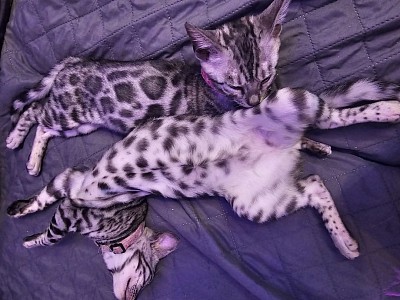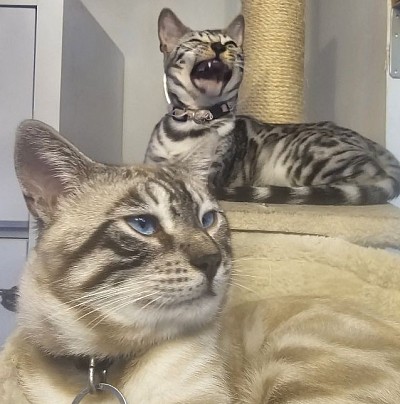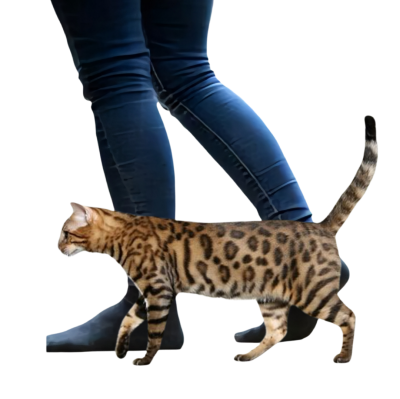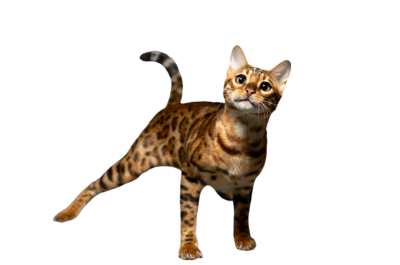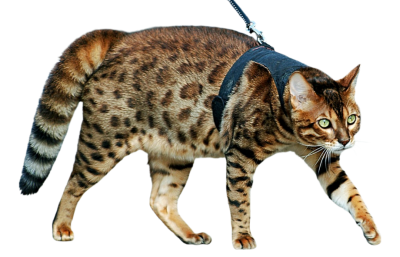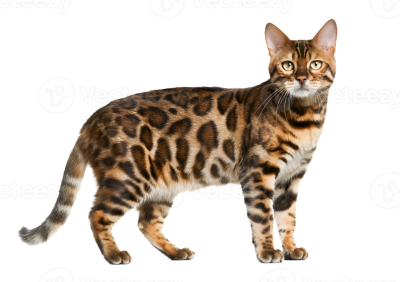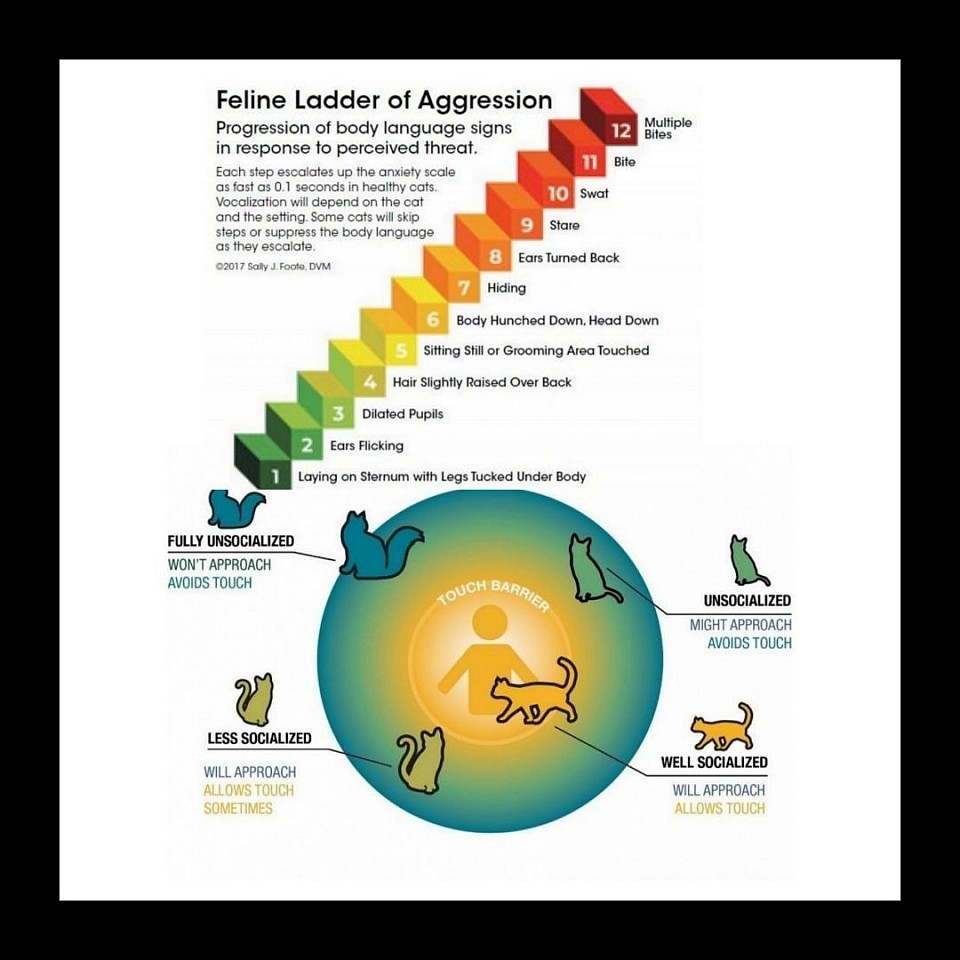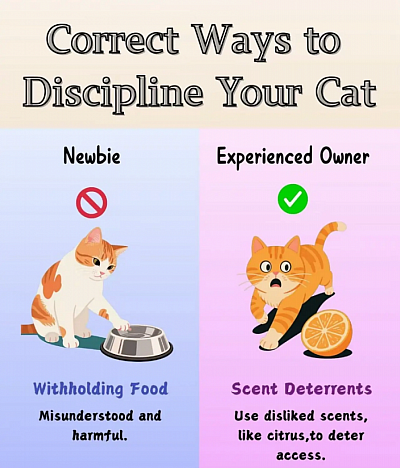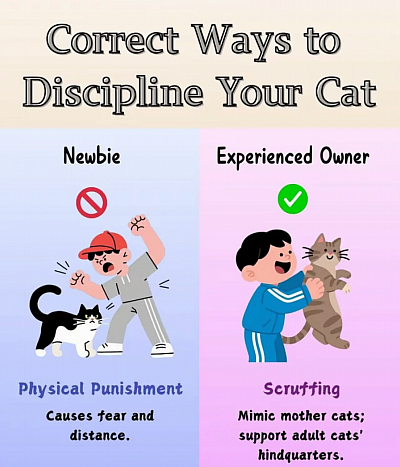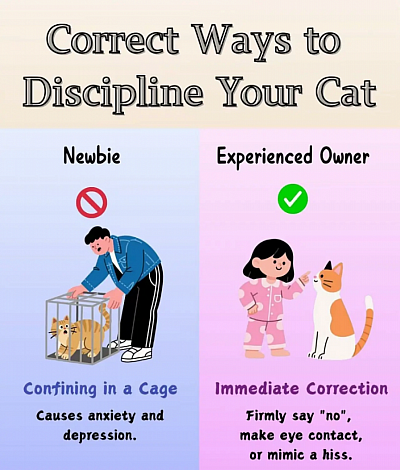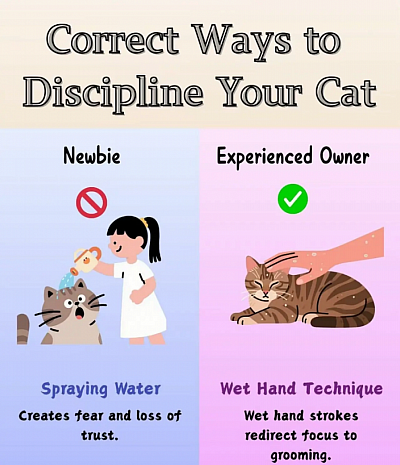Cat Mood, Cat Aggression
Cat Mood, Cat Aggression
You can get a pretty good idea of how your cat is feeling by watching its posture, sounds, and behaviour. When cats are happy and relaxed, they usually have a loose, comfy posture and might slow-blink their eyes at you. On the flip side, a puffed-up body and ears pinned back usually mean they’re scared or angry. If your cat’s mood or routine changes for a while—like hiding more or eating less—it could be a sign they’re not feeling well.
Signs of a Happy Cat
A happy cat shows its content through relaxed and loving behaviour.
- Body: A happy cat often lounges in a relaxed, loaf-like pose with smooth fur. Rolling onto their back usually means they trust you, though it’s not always an invitation for belly rubs.
- Eyes: Their eyes look soft and almond-shaped, often half-closed. Slow blinking is their way of showing affection and trust.
- Ears: Ears stand up straight and face forward, showing they’re calm and paying attention.
- Tail: An upright tail with a little curl at the tip means they’re happy and confident. A quivering tail can show excitement.
- Vocalisations: Happy cats often purr, though purring can also happen if they’re anxious or in pain. They might greet you with high-pitched meows, chirps, or trills.
- Affectionate Behaviour: Look for things like kneading their paws (“making biscuits”), rubbing their cheeks or head against you, or even drooling while purring—these are all signs they’re feeling good.
Signs of an Angry or Unhappy Cat
When upset, cats often try to look bigger and more intimidating.
- Body: An angry or scared cat might arch its back with fur standing on end (the classic “Halloween cat” look) or crouch low to the ground.
- Eyes: Pupils may be wide and dilated, with a fixed stare at whatever’s bothering them.
- Ears: Ears flatten against the head and turn to the side, sometimes called “aeroplane ears.”
- Tail: The tail might be low and tucked between the legs or thrashing and twitching quickly.
- Vocalisations: Hissing, growling, spitting, or loud yowling are clear signs they’re upset or angry.
- Defensive Behaviour: They might swat, swipe, or bite if they feel threatened.
Signs of an Anxious or Stressed Cat
Stressed cats might show subtle signs or hide away.
- Body: A tense, low-to-the-ground stance or hiding spots can mean anxiety.
- Behavioural Changes: Stress might cause too much grooming, not enough grooming, or stop grooming altogether.
- Vocalisation Changes: A usually quiet cat that suddenly meows a lot might be stressed.
- Toileting Changes: Going outside the litter box is a big red flag for stress or illness.
How to Tell if Your Cat is Sick
Cats are great at hiding pain or illness, so it’s important to watch for lasting changes in how they act or look.
- Appearance: A hunched posture, messy fur, or a visible third eyelid can mean they’re in pain or sick.
- Energy and Activity: Less activity or seeming really tired might be a sign of health issues.
- Eating and Drinking: Eating less or suddenly drinking a lot more water can be worrying.
- Vocalisations: Sometimes purring, meowing, or yowling can mean pain instead of happiness.
- Changes in Behaviour: More irritability, aggression, or sudden changes in how they interact with you might mean something’s wrong.
Important Considerations
- Context is Key: Always think about the situation. For example, a cat that’s purring but tense and hiding might actually be stressed, not happy.
- Seek Veterinary Advice: If you notice big or ongoing changes in your cat’s behaviour, mood, or routine, it’s a good idea to check with your vet to rule out any health problems.
cat aggression signs
Cat aggression can arise from a variety of factors, including territorial disputes, fear, playfulness, redirected aggression, or underlying medical issues. Understanding the cause of the aggression is essential for addressing the behaviour effectively. If a cat suddenly becomes aggressive, it is advisable to schedule a veterinary check-up to rule out any medical reasons..
Cat Mood, Cat Aggression
Cat Mood, Cat Aggression
Significance of a Cat Rubbing Against Your Legs: Communication, Affection, and Scent Marking Explained
When a cat rubs against your legs, it signifies affection, serves as a form of communication, and functions as a method of scent marking. This behaviour, known as "bunting," originates from instinctual feline social interactions and indicates a positive bond.
Sign of Affection
Greeting: Your cat is expressing happiness upon seeing you and offering a friendly salutation, commonly observed after your absence.
Trust and Comfort: By rubbing against you, your cat demonstrates trust and comfort in your presence, symbolising acceptance and inclusion within its "inner circle."
Scent Marking
Depositing Scent: Cats possess scent glands located on their cheeks, chin, forehead, and the base of their tail. When they rub against you, they transfer their unique pheromones onto your body.
Territorial Claim: Marking you with its scent signifies that your cat considers you part of its territory. This is not a possessive act but rather an affectionate indication of a bonded relationship.
Refreshing the Scent: Since pheromones diminish over time, your cat will periodically re-mark you to maintain a familiar "group scent."
Requesting Attention
Gaining Attention: Your cat may have learned that rubbing against you effectively captures your attention, potentially signalling a request for food, petting, or playtime.
Communication: Cats may also rub to indicate an issue, such as an empty food bowl, the need for fresh water, or a soiled litter box. Observing the context of the behaviour helps clarify your cat’s needs.
Recommended Response
Respond Positively: As this behaviour generally reflects a positive sentiment, reciprocate by petting, speaking to, or engaging in play with your cat to strengthen your bond.
Assess Context: Monitor accompanying behaviours, such as meowing or purring, to better understand your cat’s intentions. For example, rubbing combined with purring often signals contentment, whereas rubbing near the food area may indicate hunger.
Consider Veterinary Evaluation: Although uncommon, excessive or aggressive rubbing can suggest medical concerns such as allergies, ear infections, or fleas. If this behaviour is new or accompanied by other symptoms, consulting a veterinarian is advisable.
Quivering or Vibrating Tail in Cats: Meaning and Interpretation
A cat’s quivering or vibrating tail can indicate excitement, anticipation, or territorial marking, depending on the context and accompanying body language. This behaviour serves as a form of communication that can be better understood by observing additional cues.
Signs of Happiness and Excitement
When a cat’s tail quivers positively, it is typically held upright in a straight position. Common scenarios include:
- Greeting you: An upright, quivering tail as your cat approaches signifies pleasure at your presence.
- Anticipating food or treats: Many cats vibrate their tails in anticipation when expecting to be fed.
- During playtime: A quivering tail may indicate excitement and a playful mood.
Signs of Territorial Marking (Spraying)
If the tail quiver occurs while the cat is backing up against a vertical surface, it may indicate scent-marking behaviour. This is more common in unneutered cats but can also occur in neutered ones. Contributing factors include:
- Stress or anxiety, such as from fireworks or the introduction of a new pet.
- Territorial disputes with other cats.
- Underlying urinary issues, which may cause the cat to spray outside the litter box.
Distinguishing Between the Behaviours
Context is essential for interpreting the meaning of a quivering tail.
| Sign | Positive (Excitement) | Negative (Spraying) |
|---|---|---|
| Context | Cat is greeting you or awaiting a reward. | The cat is backing up to a vertical object, such as a wall or furniture. |
| Other Body Language | Appears happy and relaxed; may rub against you or purr. | Crouched posture focused on marking; some cats exhibit “phantom spraying” without urine. |
| Associated Behavior | Not typically associated with urine release. | Involves the release of a small amount of urine. |
When to Consult a Veterinarian
While tail quivering is generally normal, consult a veterinarian if you observe additional signs of illness or unusual behaviour. Uncontrolled tremors affecting the entire body, for example, may indicate an underlying medical condition requiring professional evaluation.
Tail Swishing in Cats: Understanding Its Meaning and Implications
A cat swishing its tail can convey various emotions, including focus, irritation, or playfulness. Unlike dogs, a swishing tail in cats does not inherently indicate happiness. To accurately interpret your cat's mood, observe the speed and intensity of the tail movement in conjunction with other body language signals.
Common reasons for a swishing tail
Focus and hunting
A slow, deliberate tail swish signifies intense concentration, often observed when a cat is in "hunting mode."
Indicators: This behaviour may occur when your cat is watching a bird through a window or preparing to pounce on a toy.
Additional cues: Dilated pupils and a crouched posture typically accompany this state.
Irritation or annoyance
A rapid, forceful swish or thump of the tail indicates agitation and a desire to be left alone.
Indicators: If your cat’s tail begins thrashing while being petted, it is a clear signal to cease interaction.
Additional cues: Flattened ears, hissing, or a sudden swat may follow if the warning is ignored.
Playfulness
During playful "predatory" behaviour, a cat may swiftly swish its tail from side to side.
Indicators: This often occurs during play with toys such as feather wands.
Additional cues: The movement is accompanied by a focused, excited demeanour and does not precede aggression, unlike an agitated swish.
Tail swishing while relaxing or sleeping
Occasionally, a cat will gently swish its tail even when calm or resting.
Overstimulation: A gentle tail swish while on your lap may indicate enjoyment of affection but also rising overstimulation; it is advisable to stop petting to prevent a potential nip.
Dreaming: A subtle twitch or swish of the tail during sleep often signifies that your cat is dreaming.
Deciphering your cat’s communication
To accurately interpret your cat’s tail language, always consider the context alongside other body language signals. Over time, you will become attuned to the unique nuances of your cat’s communication style.
Cat Tail Thumping: Indicators and Interpretations of Feline Agitation and Communication
A cat thumping its tail is a prominent indicator of irritation, agitation, or overstimulation, serving as a clear warning to maintain distance. Unlike a dog's wagging tail, a cat’s tail thumping generally does not convey happiness. This behaviour functions as a form of communication, signalling the cat’s desire for space. Interpretation of a thumping tail The significance of a thumping tail may vary slightly depending on the context and the intensity of the movement, but it is predominantly a negative signal.
- Annoyance or irritation: If your cat is resting and begins thumping its tail, it may be experiencing overstimulation or irritation caused by something in its environment.
- Warning to stop: When a cat thumps its tail during petting, it is a clear warning. Ignoring this signal may result in a bite or a swat.
- Intense focus or frustration: A cat fixated on something beyond its reach, such as a bird outside, may thump its tail out of excitement and frustration, reflecting pent-up energy without an outlet.
- Conflict: In households with multiple pets, a thumping tail can indicate tension or conflict with another animal.
How to respond to a thumping tail
- Give them space: If you observe your cat thumping its tail during petting, cease the interaction immediately and allow the cat to approach you on its own terms later.
- Observe other body language: To fully understand your cat’s mood, look for additional signs of agitation such as flattened ears, dilated pupils, or a tense posture. For example, a slight twitch of the tail tip may indicate curiosity, whereas a vigorous thump is a serious warning.
- Provide an outlet: If the thumping results from excitement, such as watching prey, redirect this energy through play using interactive toys.
When to consult a veterinarian. While tail thumping is often behavioural, it can occasionally indicate physical discomfort. If this behaviour is accompanied by symptoms such as changes in appetite, lethargy, or other unusual behaviours, it is advisable to seek veterinary advice.
Twitching Cat Tail: Understanding the Signals and Meanings
A twitching cat tail can convey a range of emotions, from mild irritation to excitement, depending on the speed and context of the movement. A gently quivering tail typically indicates positive feelings, whereas rapid, erratic movements often serve as a warning to maintain distance.
Positive or Neutral Emotions
Excitement: When a cat is particularly joyful or excited, such as upon your return home, the tip of a tail held high may quiver or vibrate. This behaviour is a friendly greeting and is considered a significant compliment from your cat.
Focus: A subtle, rapid twitching at the tail’s end can signify intense concentration, for example, when observing a bird through a window.
Dreaming: Similar to humans, cats may twitch during sleep as part of the dreaming process. A twitching tail in a sleeping cat indicates they feel secure enough to rest peacefully.
Scent-marking: When a cat holds its tail straight up and quivers while backing against a vertical surface, it may be scent-marking. This territorial behaviour, especially in spayed or neutered cats, often represents a “phantom” marking without urine spraying.
Negative or Warning Signals
Irritation or Annoyance: A slow, back-and-forth swishing or twitching motion signals that your cat is annoyed or frustrated. If you are petting them, this is a clear indication to stop to avoid a potential bite or swat.
Anger or Aggression: Increasingly aggressive or rapid tail movements—particularly whipping or thumping against the ground—indicate heightened agitation. This is a definitive sign to give your cat space.
Anxiety or Fear: A frightened or nervous cat may flick or twitch its tail while crouching low with ears flattened. This behaviour often responds to perceived threats such as loud noises or unfamiliar individuals.
Medical Conditions
While most tail twitching is behavioural, certain medical issues can cause involuntary spasms.
Pain: If a cat is lying down with a twitching or waving tail, it may indicate discomfort or illness. This is usually accompanied by other behavioural changes, such as hiding or altered appetite.
Feline Hyperesthesia Syndrome (FHS): Also known as “twitchy cat syndrome,” FHS is a rare neurological disorder characterised by skin rippling or muscle spasms along the back. Additional symptoms include sensitivity to touch, tail chasing, and excessive vocalisation.
Seizures: Seizure disorders, such as epilepsy, can cause uncontrolled twitching or jerking movements, including the tail. These episodes are often accompanied by signs like falling, drooling, or loss of consciousness.
Understanding Your Cat
To accurately interpret your cat’s tail twitching, observe the behaviour within its context alongside other body language cues, such as ear position and vocalisations. If the twitching is unusual, persistent, or accompanied by signs of illness or aggression, consulting a veterinarian is strongly recommended.
Cat Tail Wrapped Around the Body: Meaning and Interpretation
A cat wrapping its tail around its body can signify contentment, a desire for solitude, or, in some instances, defensiveness or anxiety. To accurately interpret this behaviour, it is essential to consider additional body language cues and the context of the situation.
Contentment and Relaxation: When relaxed, a cat often lies or sits with its tail curled snugly around its body, forming a compact, cosy ball. This posture provides comfort and warmth.
A "Do Not Disturb" Signal: This position may also indicate that the cat feels comfortable but prefers to be left undisturbed for a period.
Preference for Comfort: In a warm and secure environment, some cats adopt this posture simply because it is comfortable.
Anxiety or Fear: In certain circumstances, a tightly wrapped tail combined with a crouched posture can be defensive.
Signs of Nervousness: Wide eyes, flattened ears, or other stress indicators suggest the cat may feel threatened or uncertain.
Need for Space: When confronted with a perceived threat, such as an unfamiliar animal, a cat may assume this position to signal its desire for solitude.
Physical Well-being:
Conserving Warmth: Curling into a ball with the tail wrapped around the body is an effective way for a cat to retain body heat, especially in cold conditions.
Protecting Vital Organs: This posture also shields the cat’s vulnerable abdomen and vital organs, reflecting an instinctual survival mechanism that persists even in domesticated cats.
Interpreting the Situation: Observe these additional signs to better understand your cat’s message:
- Happy and Content: A cat that is purring, with half-closed eyes and a calm demeanour, is likely feeling secure and satisfied.
- Stressed or Unwell: If the cat maintains this position with a tense body, flattened ears, and dilated pupils, it may be experiencing fear, pain, or illness. Frequent or unusual occurrences of this behaviour warrant a veterinary consultation.
Puffed-Up or "Bottle-Brush" Tail: Understanding Your Cat's Instinctive Response
A puffed-up, or "bottle-brush," tail is a cat's instinctive reaction to intense emotions, designed to make them appear larger and more intimidating. This phenomenon, known as piloerection, occurs when tiny muscles contract, causing the hair to stand on end. It serves as a form of communication that can indicate various emotional states. To accurately interpret your cat’s feelings, it is essential to observe their overall body language, vocalisations, and the context of the situation.
Fear, Shock, or Defensiveness
A puffed-up tail often signals that your cat is startled, anxious, or perceives a threat. This defensive posture aims to deter potential dangers such as dogs, other cats, loud noises, or unfamiliar people. A fear-induced puff is typically accompanied by additional body language cues:
- Arched back: Resembling the classic "Halloween cat" stance.
- Flattened ears: Ears pressed back against the head.
- Dilated pupils: Eyes appear wide and alert.
- Hissing or growling: Vocalisations signalling "keep away."
- Sideways stance: Turning sideways to maximise apparent size.
Playfulness or Excitement
A puffed-up tail does not always indicate fear. It can also reflect intense play or excitement. Kittens and younger cats often exhibit "turbo tails" during energetic games such as chasing.
- Zoomies: Sudden bursts of wild running accompanied by a puffy tail, indicating high energy and enthusiasm.
- Happy greeting: Some cats puff their tails when delighted to see their owner, often combined with purring and rubbing against them, signalling positive emotions.
Aggression or Agitation
When a cat feels angry or aggressive, a puffed tail may be part of a hostile display. This type of puff differs from a defensive one and may include:
- Low body posture: Crouching close to the ground.
- Tail whipping: Rapid, back-and-forth tail movements indicating irritation or anger.
- Raised fur: Fur along the spine standing erect.
Overstimulation
Occasionally, a cat will puff its tail when overstimulated, such as during petting. This behaviour signals that the cat has reached its limit and may bite if not given space.
Recommended Actions When Your Cat’s Tail Is Puffed Up:
- Assess the situation: Determine whether your cat is playing or reacting to a stressor such as a new sound or animal. Context is crucial for understanding their mood.
- Give them space: Unless it is clearly playful behaviour, it is advisable to step back and allow your cat to calm down. Forcing interaction may be perceived as a threat.
- Observe other cues: Evaluate your cat’s entire body language—including eyes, ears, whiskers, posture, and vocalisations—to gain a comprehensive understanding.
- Consult a veterinarian: If you observe a persistently puffed tail or other signs of illness or discomfort, seek professional veterinary advice.
Cat Holding Its Tail Upright: Significance and Interpretation
A cat, including a Bengal, holding its tail upright signifies happiness, confidence, and friendly intentions. This behaviour commonly serves as a greeting, indicating the cat’s openness to interaction.
What a straight-up tail signifies
Happiness and confidence: A tail held high while the cat moves through its territory strongly indicates contentment and a sense of security.
Friendly greeting: When a cat approaches you or another amicable animal with its tail raised, it signals a desire to engage. This gesture, observed in kittens greeting their mothers, reflects a deeply ingrained social behaviour.
Sign of affection: An upright tail shows that the cat regards you as a trusted companion. This is an ideal moment for positive interactions such as petting or playing.
Excitement: A slight quiver or shake at the tip of a raised tail denotes heightened excitement or anticipation, for example, when expecting food or attention.
Is a Bengal’s tail different?
While some Bengal owners note that their cats wag their tails more frequently, the meaning of an upright tail remains consistent across breeds. However, certain breeds naturally carry their tails lower, so it is essential to consider your Bengal’s typical behaviour. Always observe additional body language cues to accurately interpret your cat’s mood.
Cat Tail Held Low: Interpretation and Significance
A cat holding its tail low to the ground can signify various states, most commonly fear, anxiety, or aggression. However, in certain breeds, this posture is natural and indicative of a relaxed state. Common causes of low tail carriage include:
Fear or anxiety: A cat with its tail held low or tucked between its legs is exhibiting a submissive and fearful gesture, indicating it feels threatened.
Pain or illness: Inability to lift the tail may suggest a tail injury, nerve damage, or other internal discomfort.
Agitation or aggression: A tail held straight downward can indicate a serious or aggressive mood, distinct from fear as the tail is not tucked.
Stalking prey: When in “stealth mode,” a cat lowers its body and tail to the ground in preparation for a pounce.
Soreness or lameness: A cat walking with a low, stiff posture may be experiencing musculoskeletal pain, warranting veterinary evaluation.
Breed-specific low tail carriage: For some breeds, a low tail is a normal resting position and does not indicate fear or aggression. Examples include:
- Persian: This breed commonly carries its tail low without any apparent reason, adopting a characteristic posture.
- American Curl: Known primarily for their distinctive ears, the breed standard describes a flexible, wide tail tapering to a rounded tip. A relaxed American Curl may hold its long tail lower than other breeds.
When to consult a veterinarian: If your cat’s low tail posture is a new or sudden behaviour accompanied by other symptoms, it is advisable to seek veterinary advice. Be attentive to signs such as:
Hook-Shaped Tail: Meaning and Interpretation in Cats
A "question mark" or "hook-shaped" tail on a Bengal cat—or any cat—commonly signifies friendliness, contentment, and a playful disposition. This behaviour is not exclusive to the Bengal breed but represents a universal feline body language cue.
Meaning of a question mark tail
When a cat holds its tail upright with a curve or hook at the tip, it conveys positive emotions, including:
- Friendliness: The cat approaches you in a warm and sociable manner, indicating openness to interaction.
- Happiness: It reflects the cat’s confidence, comfort, and overall good mood.
- Playfulness: The cat is in a playful state and may be inviting you to engage in a game.
- Greeting: Frequently, cats greet their owners with their tails in this position, similar to how kittens greet their mothers.
Interpreting the signal
To accurately interpret a cat’s tail language, consider additional contextual cues such as body posture and the surrounding environment. If your cat approaches you with a question mark tail, it is likely inviting interaction and play.
This friendly gesture contrasts with a puffed-up tail, which indicates fear or aggression, or a tucked tail, which signals anxiety or discomfort.
Effective Strategies for Cat Discipline and Behavior Management
Disciplining a Cat
The image contrasts two approaches to disciplining cats: the "Newbie" versus the "Experienced Owner" methods. According to numerous pet care professionals, the most effective and humane strategy to modify feline behaviour involves positive reinforcement and redirection rather than punishment. Many behaviours perceived as "misbehaviour" by humans, such as scratching and climbing, are in fact natural feline instincts.
Common Misconceptions (The "Newbie" Approach)
Withholding Food: Withholding food is widely regarded as a harmful and ineffective disciplinary measure. Cats do not associate this punishment with their behaviour, and it can induce fear and stress, potentially exacerbating behavioural problems.
Physical Punishment: Techniques such as hitting, yelling, or rubbing a cat’s nose in a mess are counterproductive. These actions may provoke anxiety, aggression, or withdrawal in cats, thereby damaging the owner-cat relationship. Similarly, using a spray bottle often fails because the cat learns to fear the owner rather than cease the undesired behaviour, which may persist when the owner is absent.
Effective Methods (The "Experienced Owner" Approach)
Scent Deterrents: Employing scents that cats find unpleasant, such as citrus, can be a safe and effective deterrent for specific areas. These scents can be applied to furniture or garden spaces to discourage cats without causing harm. However, caution is advised as some sources indicate that citrus essential oils may be toxic if ingested by cats.
Positive Reinforcement: Experts advocate rewarding desirable behaviour with treats, praise, or affection to encourage repetition of such actions. This method is more effective than punishment and fosters a stronger bond between the cat and the owner.
Redirection and Environmental Modifications: Rather than punishing natural feline behaviours, provide suitable alternatives. For instance, if a cat scratches the sofa, offer a sturdy scratching post nearby and reward its use. If a cat jumps on counters, provide a tall cat tree or perch as an alternative.
Effective Strategies for Cat Discipline and Behavior Management
Disciplining a Cat
The image illustrates two methods of disciplining cats: using fear and ignoring undesirable behaviour. Veterinary professionals and animal behaviourists agree that instilling fear is an ineffective disciplinary approach and can harm the relationship between the cat and the owner. Cats do not comprehend punishment as humans do; therefore, fear-inducing tactics such as yelling, hitting, or employing a spray bottle often result in increased stress, anxiety, and aggression. Rather than ceasing the unwanted behaviour, cats may develop fear toward their owner or continue the behaviour when unobserved.
A more effective strategy, as depicted in the image, involves ignoring misbehaviour while emphasising positive reinforcement. Withdrawing attention when a cat exhibits unwanted behaviour serves as a strong deterrent. This approach is most successful when combined with redirecting the cat to an appropriate alternative and rewarding desirable actions. For example, if a cat scratches furniture, guiding it to a scratching post and rewarding its use encourages proper behaviour.
Key Principles for Effective Cat Discipline:
- Positive Reinforcement: Immediately reward preferred behaviours with treats, praise, or affection.
- Redirection: Offer suitable outlets for natural behaviours such as scratching and climbing, like cat trees or scratching posts.
- Environmental Management: Modify the environment to discourage unwanted behaviours, for instance, applying double-sided tape on furniture or using motion-activated compressed air devices on countertops.
- Avoid Punishment: Refrain from yelling, hitting, or scuffing your cat, as these methods are ineffective and detrimental to your bond.
- Consult a Veterinarian or Behaviourist: Sudden behavioural changes may indicate medical issues; a veterinarian or feline behaviourist can diagnose underlying causes and recommend appropriate interventions.
Effective Strategies for Cat Discipline and Behavior Management
Physical punishment is an ineffective method for disciplining cats and may induce fear and aggression. Experts advise against its use, as cats do not comprehend punishment in the same way humans do, and it can undermine the trust between cat and owner. Scruffing is also discouraged for disciplining or handling adult cats. While mother cats scruff their kittens to carry them, kittens possess a natural reflex to go limp, which diminishes with maturity. In adult cats, scruffing causes stress, anxiety, fear, and aggression, and may also inflict physical pain or strain on the neck. It is generally reserved only for emergency medical situations as a last resort.
Effective techniques for training and correcting a cat’s behaviour include:
Positive Reinforcement: Rewarding desirable behaviour with treats, toys, or praise remains the most effective training approach.
Redirecting Behaviour: Offer suitable alternatives to discourage unwanted actions, such as providing a scratching post to prevent furniture scratching.
Environmental Modifications: Make undesired areas unattractive to cats by using deterrents like double-sided tape or aluminium foil to prevent jumping on counters.
Withdrawing Attention: If a cat misbehaves, for example by biting, immediately cease interaction and allow a brief “time out” by walking away.
Consistent “No” Command: A firm and consistent “no” can effectively discourage inappropriate behaviour without the need to raise one’s voice.
Effective Strategies for Cat Discipline and Behavior Management
Based on current knowledge, the most effective approaches to managing feline behaviour emphasise positive reinforcement and environmental modifications rather than punitive measures.
Methods to Avoid
- Physical Punishment: Actions such as hitting, shaking, or "scruffing" a cat are both harmful and ineffective. These methods can induce fear or aggression and undermine the trust between the cat and its owner.
- Yelling: Raising one’s voice can provoke stress and anxiety in cats, potentially exacerbating undesirable behaviours. Cats do not comprehend human punishment concepts and are more likely to associate negative experiences with the person rather than the behaviour.
- Confinement: Isolating a cat in a cage or separate room as punishment can lead to increased stress, anxiety, and frustration, particularly in cats prone to separation anxiety or other behavioural challenges.
- Spraying with Water: The use of a squirt bottle is a widely debunked deterrent. Cats do not link the water spray to their misbehaviour, and this practice may cause them to become withdrawn or fearful of their owner.
Effective Strategies
- Positive Reinforcement: Rewarding desirable behaviour is the most successful training method. When a cat exhibits preferred actions, such as using a scratching post, promptly reinforce this behaviour with treats, praise, or favourite toys. Consistency and immediacy are essential for the cat to associate the behaviour with the reward.
- Redirection: Redirecting a cat’s attention is an effective technique. For example, if a cat scratches furniture, gently guide it to a scratching post and encourage its use, thereby providing an appropriate outlet for natural instincts.
- Immediate Correction: A firm, low-volume “no” or a gentle clap can startle a cat and interrupt unwanted behaviour. This should be administered calmly, without yelling, and followed by rewarding the cat for ceasing the behaviour.
- Environmental Modifications: Adjusting the home environment can proactively prevent misbehaviour. Examples include applying double-sided tape or aluminium foil to surfaces to deter scratching, and providing cat trees and scratching posts to offer acceptable climbing and scratching options.
Effective Strategies for Cat Discipline and Behavior Management
According to veterinary and animal behaviour specialists, disciplining a cat using a water spray is generally discouraged. Instead, methods emphasising positive reinforcement and redirection are recommended.
Why Spraying Water Is Discouraged
Using a water spray as a disciplinary measure is ineffective for achieving long-term behavioural change. Cats tend to associate the punishment not with their undesirable behaviour, but with the individual administering it. This can result in fear and mistrust towards the owner, thereby weakening their bond. Additionally, cats may persist in the unwanted behaviour when the owner is absent.
Effective Cat Discipline Techniques
Humane and effective approaches to correcting undesirable cat behaviour involve understanding its underlying cause and offering positive alternatives. Experts suggest the following strategies:
- Positive Reinforcement: Reward desirable behaviour with treats, affection, or verbal praise.
- Redirection: Divert the cat’s attention from the unwanted behaviour to an appropriate alternative. For instance, if the cat is scratching furniture, guide it towards a scratching post and reward its use.
- Environmental Enrichment: Provide a stimulating environment equipped with toys, climbing structures, and scratching posts to satisfy the cat’s natural instincts.
- Ignoring Undesirable Behaviour: In certain cases, withholding attention for unwanted actions can effectively discourage them, as the cat receives no reinforcement.
The "wet hand technique" referenced in the image likely serves as a form of redirection. Stroking the cat with a wet hand shifts its focus to grooming, a natural self-soothing behaviour, thereby fostering positive interaction rather than inducing fear.

